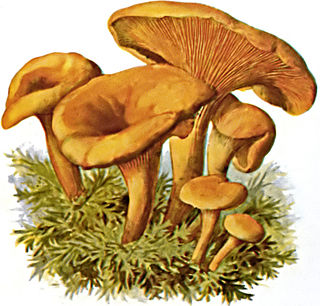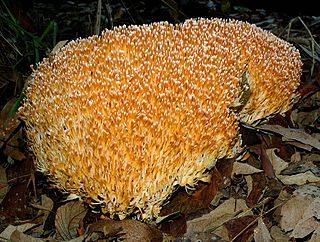
The Russulales are an order of the Agaricomycetes,. According to the Dictionary of the Fungi, the order consists of 12 families, 80 genera, and 1767 species. According to Species Fungorum, the order contains 13 families, 117 genera, and 3,060 species.

The Stereaceae are a family of corticioid fungi in the Russulales order. Species in the family have a widespread distribution, are lignicolous or terrestrial, and typically saprobic. According to the Dictionary of the Fungi, the family contains 22 genera and 125 species.

The Hygrophoropsidaceae are a family of mushrooms that are gilled in appearance but lie within the Boletales. The family contains 18 species within two genera: Leucogyrophana and Hygrophoropsis, with the best-known member being the "false chanterelle", Hygrophoropsis aurantiaca. Hygrophoropsidaceae was circumscribed by French mycologist Robert Kühner in 1980, with Hygrophoropsis as the type genus. Unlike most members of the Boletales, Hygrophoropsidaceae species are saprophytic wood-rotting fungi that cause brown rot in their hosts. The genera Austropaxillus and Tapinella, once placed in this family, are now classified in the Serpulaceae and Tapinellaceae, respectively.

Rhizopogonaceae are a family of fungi in the order Boletales. The family, first named and described by botanists Ernst Albert Gäumann and Carroll William Dodge in 1928, contains 2 genera and 151 species. The genus Fevansia, formerly thought to belong in the Rhizopogonaceae, was found to belong in the Albatrellaceae in a molecular phylogenetics study.

The Aphelariaceae are a family of fungi in the order Cantharellales. The family contains a small group of tropical and subtropical clavarioid fungi, but is not well characterized and has not been the subject of published research.

The Bankeraceae are a family of fungi in the order Thelephorales. Taxa are terrestrial, and ectomycorrhizal with plant species in families such as Pinaceae or Fagaceae. The family was circumscribed by Marinus Anton Donk in 1961. According to a 2008 estimate, the family contains 6 genera and 98 species.

The Leotiaceae are a family of fungi in the order Leotiales. Species in this family are saprobic, and have a wide distribution, especially in temperate regions. The family contains 7 genera and 34 species.

The Cenangiaceae are a family of fungi in the order Helotiales.

The Bulgariaceae are a family of fungi in the order Helotiales. Species are found in northern and southern temperate regions. The family contains four genera and seven species.

The Lachnocladiaceae are a family of fungi in the order Russulales. A 2008 estimate places 124 species in 8 genera in the Lachnocladiaceae. Species of this family, which have a widespread distribution in both tropical and temperate zones, are typically found on decaying coniferous or deciduous wood. The family was circumscribed by British mycologist Derek Reid in 1965.

The Peniophoraceae are a family of fungi in the order Russulales. Species of this family have a cosmopolitan distribution and are mostly saprobic, causing rots of standing and fallen wood. According to a 2008 estimate, the family contains 7 genera and 88 species.

The Choanephoraceae are a family of fungi in the order Mucorales. Members of this family are found mostly in the tropics or subtropics, and only rarely in temperate zones. The family currently includes species formerly classified in the family Gilbertellaceae.

The Sarcoscyphaceae are a family of cup fungi in the order Pezizales. Members of the Sarcoscyphaceae are cosmopolitan in distribution, found in both tropical and temperate regions.

The Mycenaceae are a family of fungi in the order Agaricales. According to the Dictionary of the Fungi, the family contains 10 genera and 705 species. This is one of several families that were separated from the Tricholomataceae as a result of phylogenetic analyses. Taxa in the Mycenaceae are saprobic, have a cosmopolitan distribution, and are found in almost all ecological zones. The family was circumscribed by Caspar van Overeem in 1926.

The Sarcosomataceae are a family of fungi in the order Pezizales. According to a 2008 estimate, the family contains 10 genera and 57 species. Most species are found in temperate areas, and are typically saprobic on rotten or buried wood.
The Acaulosporaceae are a family of fungi in the order Diversisporales. Species in this family are widespread in distribution, and form arbuscular mycorrhiza and vesicles in roots. The family contains two genera and 31 species.

Anthracophyllum is a genus of fungi in the family Omphalotaceae in the order Agaricales. The genus is widespread in tropical regions, and contains 10 species.

The Exobasidiaceae are a family of fungi in the division Basidiomycota, order Exobasidiales. The family contains 5 genera and 56 species. Species in the family have a widespread distribution, especially in temperate areas. Members of the Exobasidiaceae are plant pathogens that grow on the leaves of plants, especially those in the family Ericaceae.

The Chaconiaceae are a family of rust fungi in the order Pucciniales. The family contained 8 genera and 75 species in 2008. By 2020, there were 8 genera and 84 species.

The Leptosphaeriaceae are a family of fungi in the order Pleosporales. The family was circumscribed by mycologist Margaret E. Barr in 1987. According to the Dictionary of the Fungi, the family contained 8 genera and 302 species. The family has a widespread distribution, but is especially prevalent in temperate regions. Species are either saprobic or grow as nectrotrophs on the stems or leaves of plants.



















